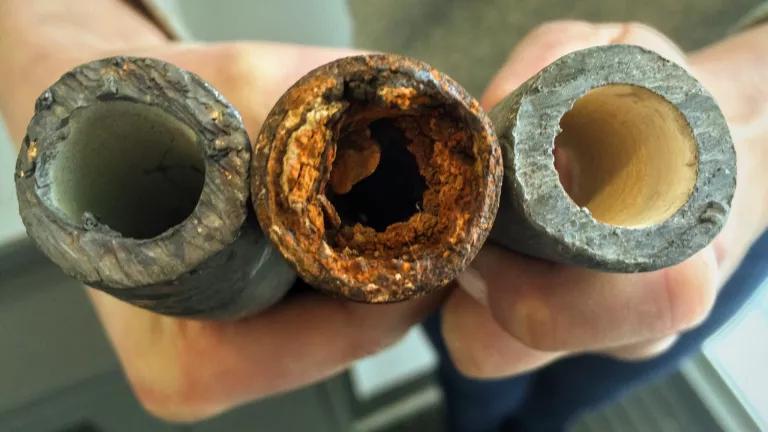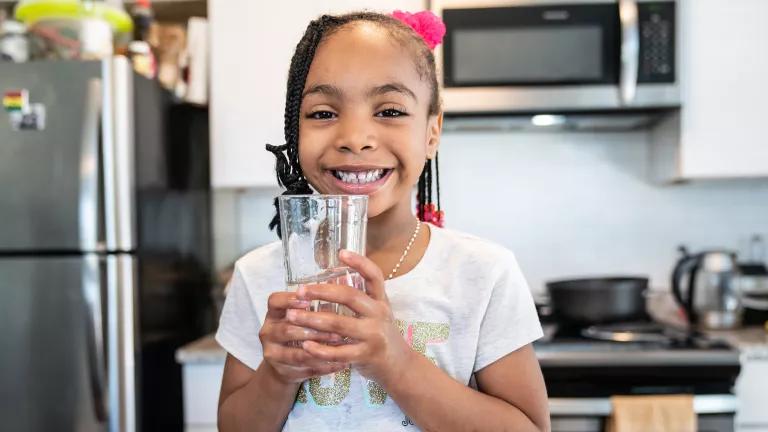Making Our Water Safe AND Affordable
Senate Hearing on May 31 Will Spotlight Water Affordability Challenges and Solutions

Unsplash/mrjn photography
Every community needs safe drinking water to protect public health and to sustain the local economy. And every single person needs access to safe water just to survive—for drinking, cooking, bathing, sanitation, and, as the COVID-19 pandemic highlighted, simply keeping our hands and homes clean to prevent disease.
Yet, in many communities, water fails to meet safe drinking water standards, which are often too weak to begin with and must be strengthened. This exposes millions of people to toxic chemicals like lead and the “forever chemicals” known as PFAS. Communities of color and lower-income communities disproportionately bear the brunt.
At the same time, in every community, there are people—often many people—who struggle to afford their water and sewer bills and face severe consequences. In multiple states, studies have found that low-income households in communities large and small, rural and urban, experience chronic challenges affording their water bills. Studies combining data from hundreds of water and sewer utilities across the country have reached the same conclusion.
When people can’t afford to pay the bill, their utility often shuts off their water and may threaten their homes with liens and foreclosure. Punitive fees trap people in a spiral of debt. And, almost unimaginably, if someone’s water is shut off, the state may take their children away. Just as with unsafe drinking water, unaffordable water bills and their consequences fall disproportionately on people of color.*
Against this backdrop, water rates continue to rise, driven largely by the need to rehabilitate, replace, and modernize aging water and wastewater infrastructure, following decades of underinvestment.
It’s a perfect storm.
(And that’s not even accounting for challenges facing people who rely on private well water or septic systems or the estimated two million people in the United States who live without running water and basic indoor plumbing (and many more without sanitation).)
Now, more than ever, we need solutions that ensure everyone has access to safe and affordable water and sanitation.
A U.S. Senate hearing on water affordability tomorrow is expected to highlight these challenges and many of the solutions. (One of the invited witnesses will be from Community Water Center, whose efforts to secure safe, affordable water service for underserved, environmental justice communities in California, and for low-income residents across the state, provides a model we all can learn from. NRDC is working closely in coalition with CWC and others in California to establish a permanent, statewide water assistance program there.)
To “solve” water affordability, we must be guided by some basic principles:
- Protect the human right to water and sanitation.
Water is life. Literally, we can’t live without it. People get that. So as a nation let’s truly live that value when it comes to providing essential water and wastewater services. The United Nations recognizes water as a human right. So should our federal, state, and local governments. That means not shutting off people’s water service, threatening their housing, or taking away their children, when they can’t afford to pay the bill. And it means not making people face the impossible choice of paying the water bill, heating bill, rent, groceries, or medicine each month. Water policy can’t solve poverty, but it can ensure access to one of life’s most basic needs.
As NRDC’s president, Manish Bapna, said in 2021: “[O]ne of the main reasons we have modern public water systems in the first place is to protect public health…We undercut those public health gains in an oddly punitive way when people’s water is cut off due to inability to pay.”
- Don’t try to fund public water systems on the backs of those least able to pay.
Water rates vary wildly across the country, even across nearby communities within a single metropolitan area. But one thing they have in common is that they are typically regressive. That is, people with the lowest incomes pay the greatest share of their income to meet their essential water needs. Why do we continue to fund water service disproportionately on the backs of those least able to pay—and so often leave the poorest communities with the most contaminated water? We need new paradigms for funding water systems fairly—with a combination of federal, state, and local funding sources and equitable water rate structures—to ensure everyone can afford safe water and sanitation.
- Ensure that affordable water is truly safe water. And ensure that affordable wastewater service provides truly clean water.
Sacrificing safe water and a healthy environment in pursuit of affordable water bills is not a solution. Nor can we sacrifice low-income households’ access to affordable water in pursuit of improving our communities’ water systems. We must ensure bills are affordable for low-income households and that water and sewer systems make the necessary improvements to protect our health.
Threats to safe, clean water abound. Toxic lead leaches from pipes, “forever chemicals” like PFAS pollute drinking water sources, and sewage overflows into rivers and bays (and even streets and yards). Too often, safe drinking water standards draw opposition from those—including some water and wastewater utilities—who claim it’s too expensive to solve these problems, or that low-income households will suffer from high bills if we try to do it in years rather than decades. We can’t stand for that.
Thankfully, the U.S. Environmental Protection Agency sent a strong signal earlier this year that it won’t pit clean water against affordable water, when it refused to accede to utilities’ demands to weaken Clean Water Act standards that could trigger rate increases. Instead, EPA pointed to a range of strategies to invest in clean water and maintain affordable bills. EPA should continue to take that same strong stand, under both the Clean Water Act and the Safe Drinking Water Act.
- Recognize that water affordability is a win-win for everyone.
Send people a bill they can’t afford and they may not pay it. Send a bill they can afford and they’re much more likely to pay it—voluntarily and on time. And when they do, across an entire community, it provides a more stable, predictable revenue stream for water systems to maintain, operate, and improve vital infrastructure.** That means that programs to ensure bills are affordable for low-income residents do not only benefit low-income residents. They benefit everyone who depends on a well-funded water system to sustain their family and their community.
Put another way: water affordability is both a moral and practical imperative. To protect the basic human right to water and sanitation for all of us, we must ensure that bills are affordable for those least able to pay (and that no one loses service if they cannot pay). The alternative fails not only the most vulnerable in our society, but everyone who depends on high quality water and sewer service.
* * * * *
Increasingly, leaders in the water utility sector are recognizing these basic truths and talking openly about them. Some are even joining with frontline community advocates to call for fundamental changes. And some are taking action locally. Policy makers at all levels need to do the same. We’re all in this together.
We need a comprehensive approach to safe and affordable water.
Achieving universal access to safe, affordable water will take all the tools in the toolkit, including:
- Enacting and enforcing strong drinking water standards and clean water standards.
- Providing federal and state infrastructure funding that prioritizes disadvantaged communities, and ensuring that it actually reaches those communities.
- Changing how we set water rates and collect on water bills. This includes strategies to ensure that essential water services are affordable for low-income households and that no one loses access to water if they cannot pay, such as:
--> adopting equitable local water rates;
--> creating federal, state, and local low-income affordability and assistance programs;
--> establishing protections for people when they fall behind on their water bills; and
--> improving transparency and accountability of water systems to the people they serve.
As to that last set of solutions (ensuring affordable bills and maintaining access to water), NRDC recently published an extensive Water Affordability Advocacy Toolkit, along with the National Consumer Law Center (NCLC). The Toolkit lays out a roadmap for advocates and policy makers alike.
The NRDC/NCLC Toolkit focuses especially on what utilities can do at the local level, gathering many of the best examples from around the country. But many of the strategies found there can also be pursued—and all of the strategies can at least be supported—by states and the federal government. As the Senate hearing approaches, here are some of the immediate steps the federal government can take to advance water affordability.
- Congress should:
--> Create a permanent low-income water assistance program—a widely popular idea among voters—similar to long-standing programs that help people afford energy utility bills.
--> Extend funding for an existing, temporary program as a stopgap, until a permanent program is established.
--> Use federal resources to leverage additional state and local solutions, while holding water systems accountable for providing service to all residents regardless of income.
--> Mandate collection of data to track shutoffs, residential customer debt, and other indicators of affordability challenges and the impacts of utility collections practices.
- EPA should:
--> Expeditiously complete the “needs assessment” required by the Bipartisan Infrastructure Law (sec. 50108), which calls for comprehensive recommendations “regarding the best methods to reduce the prevalence of a lack of affordable access to water services.”
--> Hold the line on strong drinking water standards, against those who say it’s impossible to have water that’s both free of toxic contamination and affordable for everyone.
--> Ramp up technical assistance to communities on comprehensive affordability solutions.
--> Use existing authorities to require water and wastewater systems to report data on shutoffs, residential customer debt, and other key indicators.
NOTES:
* In case anyone thinks water shutoffs are a problem faced only by people in blue states, or in the poorest cities, my email inbox from the last few years can dispense with that notion. During the COVID-19 pandemic, I’ve received unsolicited emails from individuals desperate for help keeping the water on for their families. (Presumably they had seen my name somewhere online, in connection with NRDC’s advocacy to protect people from water shutoffs.) They were not in blue states, or in large cities with high poverty rates. Here are a few of them, in their own words:
“I have a three months past due water bill and a two months over gas invoice. Our water is being shut off this morning. We are a family of five with no income and a fifteen year old son with severe disabilities…” (Sent from a large city in Oklahoma, in August 2021.)
“I am in desperate need of assistance in paying my past due water bill….The city…wants payment in full. I owe over $1000. My hours were cut to part time during Covid and I was the only adult still working. I also need assistance with mortgage payments but the water bill is priority. Please advise. I am without water.” (Sent from a very small city in Texas, in May 2021.)
“My water has been shut off since June 1... I'm on oxygen and can't wash my hands during this virus.” (Sent from a rural county in Missouri, in mid-June 2020.)
To offer one more “red state” example, one of the contributing reviewers to our Water Affordability Advocacy Toolkit is an advocate in Martin County, Kentucky, where unaffordable bills fundamentally threaten the local utility’s capacity to deliver safe and reliable water and sanitation service.
** In early June, check back HERE for a new tool that allows utilities to assess the “business case” for providing discounts to low-income customers.




